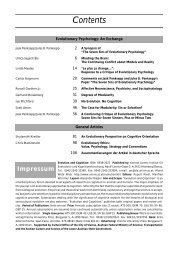Contents - Konrad Lorenz Institute
Contents - Konrad Lorenz Institute
Contents - Konrad Lorenz Institute
You also want an ePaper? Increase the reach of your titles
YUMPU automatically turns print PDFs into web optimized ePapers that Google loves.
Fredric J. Heeren<br />
1999, p2). DAVIES has long wondered if biologists<br />
would see the constraints and the bio-friendly pattern<br />
too.<br />
CONWAY MORRIS sees something like it: “Consider,<br />
for example, the sponges”, he writes, “which by general<br />
consent are the most primitive living metazoans.<br />
Nevertheless, their biochemistry includes elements<br />
that seem to foreshadow the immune system<br />
of vertebrates” (CONWAY MORRIS 2000; SCHÄCKE et al.<br />
1994). Though sponges do not have nerve cells, they<br />
already have neuronal-like receptors, so that they<br />
“seem to be almost ‘animals in waiting’” (CONWAY<br />
MORRIS 2000). CONWAY MORRIS believes that caution<br />
is in order and that such findings can be carried too<br />
far, producing a distorted view; yet he continues listing<br />
examples of what appear as preadaptations, such<br />
as the nervous system of amphioxus revealing “a<br />
vertebrate in waiting” (Ibid).<br />
Similarly, recent genetic studies of hemichordates,<br />
which have no brains, show that these most<br />
plausible models for proximate ancestors to chordates<br />
already contain the genes that express the<br />
brain and spinal cord in vertebrates (LACALLI 2003).<br />
Hemichordate genes that are responsible for patterning<br />
the body along its front-to-back axis were<br />
found expressed in the surface tissue in a nearly<br />
identical arrangement to those that express themselves<br />
in vertebrate brains and spinal chords (LOWE<br />
et al. 2003). LOWE et al. favor the idea that a complex<br />
genetic map was in place long before the complex<br />
morphology.<br />
The bottom line, according to CHEN, is that the<br />
standard mechanisms of neo-DARWINISM offer no<br />
basis for a “ladder of progress”. So far, a noncontroversial<br />
view. But if his “top-down” alternative gains<br />
acceptance, it would create a paradigm shift in biology.<br />
His replacement of competition with harmony<br />
and top-down evolution could be taken to suggest<br />
the first rungs in such a guiding ladder. CHEN’s discovery<br />
of Haikouella shows that the last really big<br />
turn in the pathway to humanity did not occur at<br />
the end of the evolutionary process, but at the beginning.<br />
Does this mean that the “goal” of humanity<br />
was set from the beginning of metazoan life Few<br />
other participants at the Kunming conference were<br />
willing to say anything like that. But some did, including<br />
New Zealand geneticist Michael DENTON.<br />
Arguing from the fact that almost no new phyla<br />
evolved after the Cambrian explosion, DENTON said:<br />
“The body plans of the Cambrian are probably built<br />
into nature from the beginning” (DENTON 1999).<br />
DENTON is part of a team that recently revealed how,<br />
at its base, life follows “laws of form” in the discrete,<br />
three-dimensional folding patterns of protein molecules.<br />
The folds can be classified into a finite number<br />
of structural families that are determined by natural<br />
law, not natural selection—much like the<br />
physical laws that give rise to atomic elements in<br />
the periodic table. Writing for the Journal of Theoretical<br />
Biology, his team describes the protein folds as<br />
“‘lawful forms’ in the Platonic and pre-DARWINIAN<br />
sense of the word, which are bound to occur everywhere<br />
in the universe where the same 20 amino acids<br />
are used for their construction” (DENTON/MAR-<br />
SHALL/LEGGE 2002). In another piece, for Nature,<br />
DENTON and MARSHALL argue: “If forms as complex<br />
as the protein folds are intrinsic features of nature,<br />
might some of the higher architecture of life also be<br />
determined by physical law” (DENTON/MARSHALL<br />
2001).<br />
Moreover, given the limitations of a material<br />
world of flux, DENTON considers the possibility that<br />
“the laws of nature are fit for only one unique thinking<br />
being capable of acquiring knowledge and ultimately<br />
comprehending the cosmos” (DENTON<br />
1998). He cites Mark WARD’s research on the fine balance<br />
achieved (1) between the size/number of neurons<br />
and the blood vessels which nourish them, and<br />
(2) between the width of axons and the required insulation/blood<br />
supply (WARD 1997). Referring to<br />
this and to the staggering compaction of synaptic<br />
connections in the human brain, he writes that “the<br />
evidence is certainly consistent with the possibility<br />
that the human brain does indeed represent the<br />
most advanced information-processing device that<br />
can be built according to biological principles”<br />
(DENTON 1998).<br />
However, to say that the experience of consciousness<br />
is fully explained by the physical laws that produce<br />
such a brain is a non sequitur, except to committed<br />
reductionists. Physicists from Brian PIPPARD<br />
to Stephen WEINBERG have raised questions about<br />
the reasonableness of expecting consciousness<br />
itself 11 to ever be subsumed under the domain of<br />
physics and chemistry (PIPPARD 1992; WEINBERG<br />
1992, p44). Given a complex structure with ample<br />
computing power, should a theoretical physicist be<br />
able to deduce the existence of self-awareness from<br />
laws of physics Cognative scientist David J. CHALM-<br />
ERS suggests that the problem of trying to derive consciousness<br />
from physical laws is so troublesome that<br />
any final theory of physics “must contain an additional<br />
fundamental component”. He proposes “that<br />
conscious experience be considered a fundamental<br />
feature, irreducible to anything more basic” (CHALM-<br />
ERS 1995).<br />
Evolution and Cognition ❘ 152 ❘ 2003, Vol. 9, No. 2








